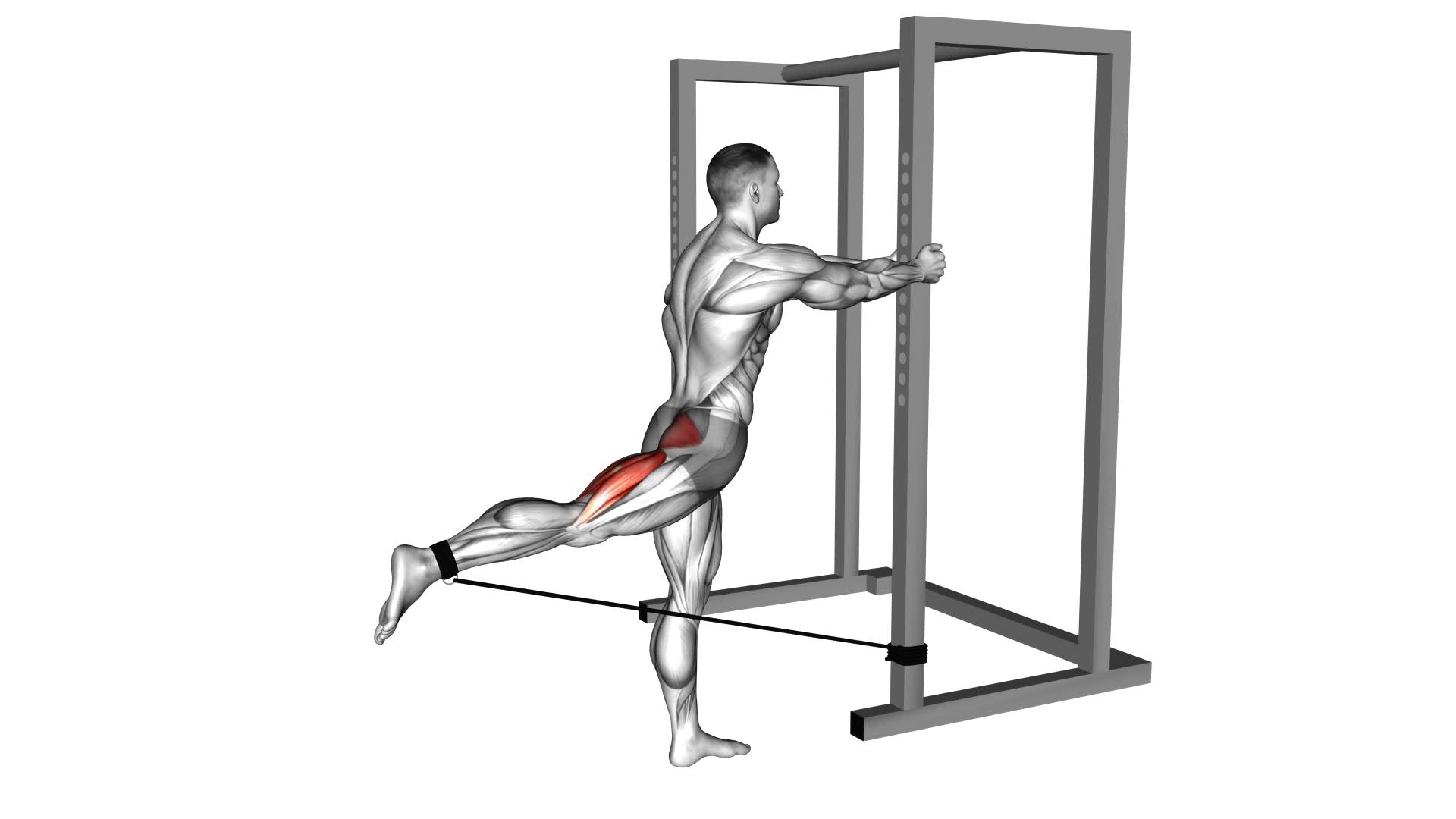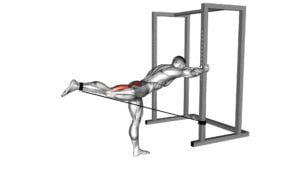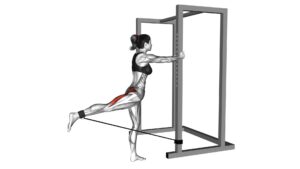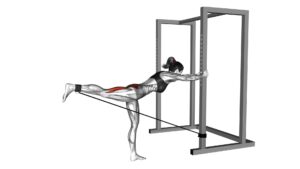Band Standing Hip Extension (male) – Video Exercise Guide & Tips

Ready to amp up your leg workout? Look no further than the Band Standing Hip Extension. This exercise targets your glutes, hamstrings, and quadriceps, giving you a strong and sculpted lower body.
Watch This Exercise Video
In this video exercise guide, we'll walk you through the proper setup, step-by-step instructions, and common mistakes to avoid. Plus, we'll share variations and expert tips to help you maximize your results.
So grab your resistance band and get ready to feel the burn!
Key Takeaways
- Band standing hip extension targets the glutes, hamstrings, and quadriceps, improving hip strength and stability.
- Proper equipment and setup, including choosing the appropriate band tension and maintaining proper alignment and positioning, are important for performing the exercise correctly.
- Finding the correct band tension is crucial, as it should challenge the muscles without compromising form.
- Engaging the core muscles is vital for stability, proper form, preventing lower back strain, and maximizing the effectiveness of the exercise.
Benefits of Band Standing Hip Extension
You will experience significant improvements in hip strength and stability by incorporating band standing hip extensions into your workout routine. These exercises are highly beneficial for injury prevention and muscle activation.
Band standing hip extensions target the gluteus muscles, specifically the gluteus maximus, medius, and minimus. These muscles play a crucial role in stabilizing the hip joint and maintaining proper alignment during movement. Strengthening these muscles can help prevent common hip injuries such as strains and imbalances.
By using resistance bands during the exercise, you add an extra challenge to the movement, increasing muscle activation and promoting greater strength gains. The bands provide constant tension throughout the movement, forcing your glutes to work harder. This increased muscle activation leads to improved overall hip strength and stability.
Additionally, band standing hip extensions also help to activate the core muscles. Your core muscles play a vital role in maintaining balance and stability during exercises. Strengthening your core can further enhance your ability to prevent injuries and maintain proper form throughout your workouts.
Incorporating band standing hip extensions into your routine can be done as part of a warm-up or as a standalone exercise. Aim for 2-3 sets of 10-15 repetitions on each leg, gradually increasing the resistance of the band as your strength improves. Remember to maintain proper form throughout the exercise, engaging your glutes and core muscles for maximum effectiveness.
Proper Equipment and Setup
To ensure proper equipment and setup for the Band Standing Hip Extension exercise, there are a few key points to keep in mind.
First, make sure the band tension is appropriate for your strength level, providing enough resistance without being too difficult.
Secondly, focus on maintaining proper alignment and positioning throughout the exercise, keeping your core engaged and your spine in a neutral position.
Correct Band Tension
Achieve optimal band tension by properly setting up your equipment for the band standing hip extension exercise.
To ensure the correct band tension, follow these band tension tips.
First, choose a band with the appropriate resistance level for your fitness level. If the band is too loose, it won't provide enough resistance to effectively target your hip muscles. On the other hand, if the band is too tight, it may put excessive strain on your joints and lead to injury.
To modify band tension, you can either adjust the length of the band or use a different band with a higher or lower resistance level. Experiment with different bands and lengths until you find the right tension that challenges your muscles without compromising your form.
Proper Alignment and Positioning
To ensure proper alignment and positioning for the band standing hip extension exercise, focus on the placement and setup of your equipment. Proper alignment and positioning are crucial for maximizing the benefits of this exercise and reducing the risk of injury. Here are some key points to keep in mind:
- Attach the resistance band securely to a stable anchor point at hip height.
- Stand with your feet shoulder-width apart and parallel to each other.
- Position yourself far enough away from the anchor point so that there's tension in the band when your leg is extended.
By maintaining proper alignment and positioning, you can effectively target your glutes and hamstrings while minimizing strain on other muscles. This will help improve your hip strength, stability, and overall athletic performance.
Remember to always prioritize safety and consult a fitness professional if you have any concerns or questions.
Step-by-Step Guide for Performing the Exercise
To ensure you perform the Band Standing Hip Extension exercise correctly and effectively, it's important to be aware of common mistakes to avoid and focus on proper form and technique.
By avoiding swinging your leg or using momentum, you can target and engage the glutes and hamstrings more effectively.
Additionally, maintaining a neutral spine and squeezing your glutes at the top of the movement will help maximize the benefits of this exercise.
Common Mistakes to Avoid
Avoid these common mistakes when performing the Band Standing Hip Extension exercise to ensure proper form and maximize results.
- Not engaging the glutes: One common mistake isn't properly activating the glute muscles during the exercise. To avoid this, focus on squeezing your glutes at the top of the movement and maintaining tension throughout.
- Using too much resistance: Using a band with too much resistance can lead to improper form and potential injury. Start with a lighter band and gradually increase resistance as you become more comfortable with the exercise.
- Swinging the leg: Swinging the leg during the hip extension can take away from the effectiveness of the exercise and increase the risk of injury. Keep your movements controlled and avoid any swinging or jerking motions.
Remember, proper form is crucial for avoiding injury and getting the most out of this exercise.
If you're struggling with the Band Standing Hip Extension, there are alternative exercises like glute bridges or donkey kicks that can also target the glute muscles effectively.
Proper Form and Technique
To perform the Band Standing Hip Extension exercise with proper form and technique, follow these step-by-step instructions.
- Begin by attaching a resistance band around your ankles and stand with your feet hip-width apart.
- Keep your back straight and engage your core muscles.
- Start by shifting your weight onto one leg while lifting the opposite leg backward, maintaining a slight bend in the knee.
- Avoid arching your lower back or leaning forward during the movement.
- Slowly lower your leg back down to the starting position and repeat on the opposite side.
- Focus on squeezing your glute muscles throughout the exercise to ensure proper muscle activation.
Common Mistakes to Avoid
When performing the Band Standing Hip Extension exercise, be mindful of improper form to maximize results.
Here are some common mistakes to avoid and some technique tips to help you perform the exercise correctly:
- Using too much momentum: It's important to control the movement and not rely on momentum to lift your leg. This can lead to a less effective workout and increase the risk of injury. Focus on using your glute muscles to lift your leg instead of swinging it.
- Arching your lower back: Avoid arching your lower back excessively during the exercise. This can put unnecessary strain on your lower back and reduce the effectiveness of the exercise. Engage your core muscles and maintain a neutral spine throughout the movement.
- Not fully extending your hip: Make sure to fully extend your hip at the top of the movement. This means lifting your leg as high as possible without compromising your form. This will help target your glute muscles more effectively.
By avoiding these common mistakes and following these technique tips, you can ensure that you're getting the most out of your Band Standing Hip Extension exercise.
Remember to always listen to your body and adjust the resistance of the band as needed.
Variations and Progressions
To add variety and challenge to your Band Standing Hip Extension exercise, try incorporating different variations and progressions. By incorporating these variations, you can target different muscle groups and increase muscle activation for a more effective workout.
One variation you can try is the Single-Leg Band Standing Hip Extension. This exercise involves standing on one leg while performing the hip extension movement. By performing the exercise on one leg, you challenge your balance and stability, while also targeting the glutes and hamstrings more effectively.
Another variation is the Band Standing Hip Abduction. Instead of extending your leg backward, you'll be lifting it sideways. This targets the outer hip muscles, specifically the gluteus medius, which helps stabilize the pelvis and improve hip stability.
For a more advanced progression, you can incorporate a resistance band with higher tension. This will increase the resistance and make the exercise more challenging, resulting in greater muscle activation and strength gains.
Remember to always maintain proper form and control throughout these different exercises and progressions. Start with a lower resistance or intensity level and gradually increase it as you become more comfortable and stronger.
Expert Tips for Maximum Results
To maximize your results, consistently incorporate expert tips into your Band Standing Hip Extension exercise routine. Here are some tips that can help beginners get started and provide advanced modifications for those looking for an extra challenge:
- Start with a lighter resistance band: If you're new to this exercise, it's important to start with a band that provides enough resistance to challenge your muscles but isn't too difficult to control. As you become more comfortable and stronger, you can gradually increase the resistance.
- Focus on proper form: It's crucial to maintain proper form throughout the exercise to target the right muscles and prevent injuries. Keep your core engaged, back straight, and shoulders relaxed. Avoid arching your back or using momentum to lift your leg.
- Incorporate tempo variations: To further challenge your muscles and increase the effectiveness of the exercise, try incorporating different tempos. Slow down the movement on the way up and down, or pause at the top of the movement for a few seconds before lowering your leg.
By following these tips, beginners can start their Band Standing Hip Extension routine with confidence, while advanced individuals can make modifications to keep pushing their limits and achieving maximum results.
Remember to listen to your body and adjust the exercise intensity as needed.
Frequently Asked Questions
How Many Sets and Reps Should I Perform for Band Standing Hip Extension?
For the band standing hip extension exercise, the number of sets and reps you should perform depends on your fitness level and goals. It's generally recommended to start with 2-3 sets of 10-12 reps.
As you become more comfortable and stronger, you can increase the number of sets and reps.
Additionally, there are variations of this exercise that you can incorporate to target different muscles and add variety to your workout routine.
Can Women Also Perform This Exercise?
Yes, women can definitely perform the band standing hip extension exercise. It offers several benefits for women, such as strengthening the glutes and improving overall hip stability.
Additionally, there are variations of this exercise that can be tailored to different fitness levels. Whether you're a beginner or advanced, you can adjust the resistance of the band or modify the range of motion to suit your individual needs and goals.
Is It Normal to Feel a Burn in the Glutes During Band Standing Hip Extension?
During the band standing hip extension exercise, it's normal to feel a burn sensation in your glutes. This is a sign that your muscles are being activated and worked effectively.
The burn indicates that you're targeting and engaging the glute muscles, which is the goal of this exercise.
It's important to listen to your body and make sure you're performing the exercise with proper form to maximize muscle activation and minimize the risk of injury.
Can I Use Dumbbells Instead of Resistance Bands for This Exercise?
Sure, you're wondering if you can use dumbbells instead of resistance bands for the band standing hip extension exercise.
While dumbbells can be used for other exercises, this particular exercise is best performed with resistance bands. Resistance bands provide a unique tension that activates and strengthens the glute muscles effectively.
They also allow for a greater range of motion and target specific muscle groups.
Are There Any Modifications for Individuals With Knee or Hip Injuries?
If you have knee or hip injuries, there are modifications you can make for the band standing hip extension exercise. Instead of using a resistance band, you can try using a cable machine or ankle weights to target your glutes and hamstrings.
Another alternative exercise is the glute bridge, which is done lying on your back with your knees bent. This exercise can help strengthen your hips without putting too much strain on your knees or hips.
Conclusion
In conclusion, the band standing hip extension exercise is a beneficial way to strengthen and tone the hip muscles. By using a resistance band, you can effectively target the glutes and hamstrings, improving overall lower body strength and stability.
It's important to use proper equipment and technique to maximize results and avoid common mistakes. With variations and progressions, you can continue to challenge yourself and see continued improvement in your hip strength and mobility.

Author
Years ago, the spark of my life’s passion ignited in my mind the moment I stepped into the local gym for the first time. The inaugural bead of perspiration, the initial endeavor, the very first surge of endorphins, and a sense of pride that washed over me post-workout marked the beginning of my deep-seated interest in strength sports, fitness, and sports nutrition. This very curiosity blossomed rapidly into a profound fascination, propelling me to earn a Master’s degree in Physical Education from the Academy of Physical Education in Krakow, followed by a Sports Manager diploma from the Jagiellonian University. My journey of growth led me to gain more specialized qualifications, such as being a certified personal trainer with a focus on sports dietetics, a lifeguard, and an instructor for wellness and corrective gymnastics. Theoretical knowledge paired seamlessly with practical experience, reinforcing my belief that the transformation of individuals under my guidance was also a reflection of my personal growth. This belief holds true even today. Each day, I strive to push the boundaries and explore new realms. These realms gently elevate me to greater heights. The unique combination of passion for my field and the continuous quest for growth fuels my drive to break new ground.



